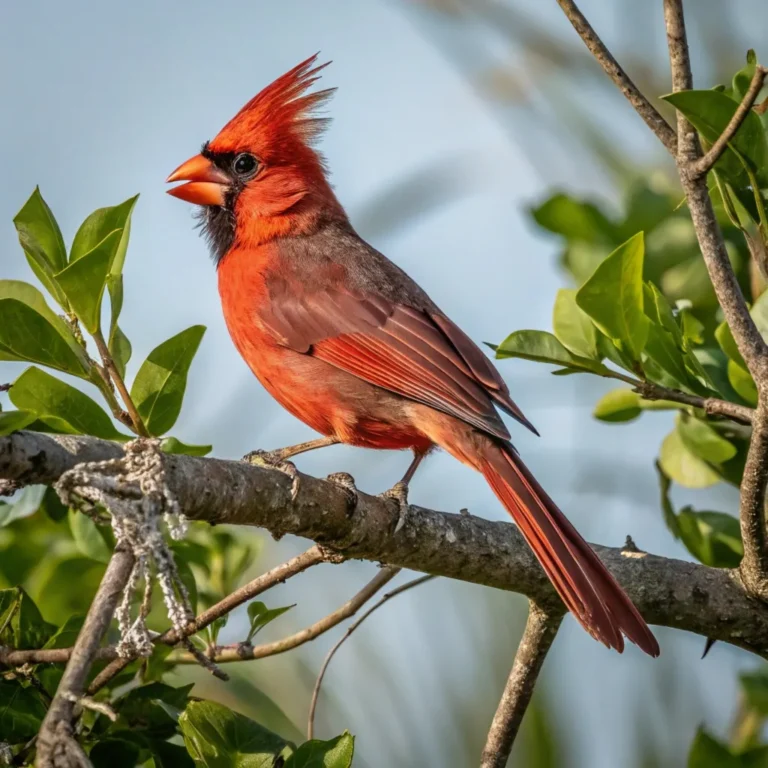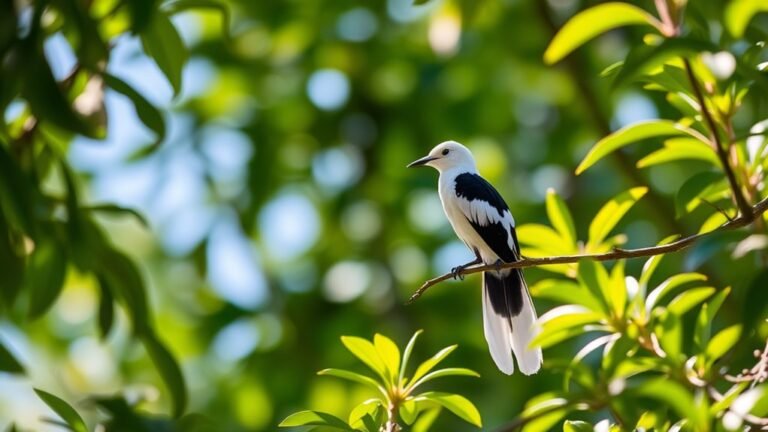Black Bird of Paradise Plant Care Guide
Caring for a Black Bird of Paradise plant requires knowledge of its light, soil, and moisture needs. This plant thrives in conditions similar to its native South Africa. To promote healthy growth and beautiful blooms, provide the right environment and watch for pests.
Adjust care with the seasons. In spring and summer, ensure it receives ample sunlight and water regularly. In fall and winter, reduce watering as the plant enters a resting phase.
Propagation can be done through division or by seeds. Divide the plant in spring or summer when it is actively growing. For seeds, plant them in warm, moist soil and keep them in a sunny location.
By following these guidelines, you can enjoy a thriving Black Bird of Paradise plant that adds beauty to your space.
Key Takeaways
- Provide bright, indirect light for at least six hours daily. If outside, give the plant partial shade to protect the leaves.
- Use a well-draining potting mix. Combine perlite and orchid bark to prevent root rot.
- Water deeply but infrequently. Let the top inch of soil dry out between waterings.
- Check for pests like aphids, spider mites, and mealybugs. Look for signs of fungal infections.
- Rotate indoor plants occasionally. This helps distribute light evenly and promotes balanced growth.
Understanding the Black Bird of Paradise Plant
The Black Bird of Paradise plant (Strelitzia reginae) offers a striking addition to any garden. This plant comes from South Africa and thrives in warm climates. Its large, paddle-shaped leaves can reach up to 18 inches wide, creating a bold visual impact.
The plant grows upright and can reach a height of 4-6 feet, making it a standout feature in landscaping. As it matures, the Black Bird of Paradise produces exotic blooms that resemble the plumage of vibrant birds.
These unique flowers draw attention and add charm to your garden. Knowing how to care for this plant will deepen your connection to your garden's beauty. Enjoy the process of nurturing your Black Bird of Paradise and watch it transform your outdoor space into a tropical paradise.
Ideal Lighting Conditions
To help your Black Bird of Paradise thrive, provide the right lighting conditions. This plant grows best in bright, indirect light, so aim for at least six hours of indoor light each day.
If placing it outside, find a location with partial shade to protect it from harsh afternoon sun, which can harm the leaves. While it can handle some direct sunlight, too much can slow its growth and affect its health.
For indoor plants, rotate them occasionally to ensure they receive light evenly, promoting balanced growth.
Good lighting enhances the plant's vibrant foliage and boosts your gardening pride.
Soil Requirements and Potting
To help your Black Bird of Paradise grow well, use a potting mix that drains easily. A good option is a mixture of potting soil, perlite, and orchid bark. This blend allows air and water to move freely, which helps prevent root rot.
You can also try using a cactus mix, but add some organic matter for better results.
When you pot your plant, choose a slightly larger container. This gives your plant space to grow and reduces the need for frequent repotting.
Before placing your plant in its new pot, gently loosen the roots. This will help your plant start strong in its new environment.
Watering Practices
After potting your Black Bird of Paradise with the right soil mix, it's important to understand its watering needs for healthy growth.
Use filtered or distilled water to avoid harmful chemicals like chlorine. Water deeply but infrequently, allowing the top inch of soil to dry out between waterings. This approach encourages strong root development and helps the plant tolerate drought.
Adjust your watering schedule with changes in seasons and indoor conditions. In winter, water less as the plant becomes dormant.
Temperature and Humidity Needs
To keep your Black Bird of Paradise healthy, maintain a temperature between 65°F and 80°F (18°C to 27°C). Avoid cold drafts and sudden changes in temperature, as they can damage the leaves.
For humidity, aim for levels between 50% and 65% for optimal growth. If your space is dry, use a humidifier or place the pot on a pebble tray filled with water to add moisture.
Regularly misting the plant can help, but be sure not to let water collect on the leaves to avoid fungal problems. Proper care will help your plant thrive in its environment.
Fertilizing Your Plant
To help your Black Bird of Paradise grow well, provide it with the right nutrients by fertilizing regularly.
Use a balanced fertilizer to ensure your plant gets the nutrients it needs. Fertilize during the growing season, which is usually from spring to early fall.
Here are some key points to remember:
- Use a balanced, slow-release fertilizer.
- Choose fertilizers high in nitrogen to support leaf growth.
- Apply liquid fertilizers every 4-6 weeks for fast nutrient uptake.
- Avoid over-fertilizing to prevent root burn.
- Keep an eye on your plant's growth and adjust the feeding schedule if necessary.
Pruning and Maintenance
Fertilizing your Black Bird of Paradise is essential for its health. Regular pruning and maintenance are also important.
Prune during spring to improve air circulation and encourage new growth. Make angled cuts just above leaf nodes to reduce damage and promote healing. Remove dead or damaged leaves to maintain the plant's health and appearance.
Trim spent flowers to encourage more blooms. Always sterilize your pruning tools to avoid spreading disease. Following these steps will enhance your plant's look and create a better environment for growth.
Pests and Diseases to Watch For
While caring for your Black Bird of Paradise, it's crucial to monitor it for pests and diseases. Effective pest identification and disease prevention can help protect your plant.
Watch for these common threats:
- Aphids: These small insects suck sap from leaves and cause distortion.
- Spider Mites: Tiny and hard to see, they create webbing and yellow leaves.
- Mealybugs: These pests appear as white, cotton-like clusters and can weaken stems.
- Fungal Infections: Check for brown spots or powdery mildew on leaves.
- Root Rot: This condition occurs due to overwatering and poor drainage.
Inspect your plant often and deal with any problems quickly. By staying alert, you can keep your Black Bird of Paradise healthy and vibrant.
Propagation Techniques
To grow the Black Bird of Paradise, you can use two main methods: seed propagation and division.
For seed propagation, collect seeds from a mature plant. Soak the seeds in water for 24 hours to help them germinate. Then, plant the seeds in a well-draining potting mix. Keep the mix warm and moist until the seeds sprout.
For the division method, carefully take the plant out of its pot. Use a sharp, sterile knife to divide the root ball into sections, making sure each section has roots and leaves.
Plant these sections in new pots with fresh soil, water them, and place them in bright, indirect light.
Both methods can help you expand your collection of these beautiful plants. Happy gardening!
Frequently Asked Questions
Can the Black Bird of Paradise Survive Outdoors in My Climate?
To check if the black bird of paradise can survive outdoors in your climate, look at your local weather. This plant grows well in warm and humid places. If your area has frost or long periods of cold, the black bird of paradise probably won't survive outside all year.
How Fast Does the Black Bird of Paradise Grow?
The black bird of paradise grows quickly in ideal conditions, reaching up to 6 feet in height within one season. You can promote faster growth by using methods like division or seed planting. This makes it a great choice for gardeners who want to see results in a short time. With proper care, you can enjoy the beauty of this plant in your garden.
Is the Black Bird of Paradise Toxic to Pets?
The Black Bird of Paradise is safe for pets. It does not contain toxins that could harm them. However, it's wise to keep an eye on your pets around any plants. Some pets may react differently, so observe their behavior closely.
What Is the Lifespan of a Black Bird of Paradise Plant?
The Black Bird of Paradise plant can live for 15 years or more if you provide proper care. To help it thrive, ensure it gets enough light and humidity. Water it regularly to support its growth.
Can I Grow a Black Bird of Paradise From Seed?
Yes, you can grow a Black Bird of Paradise from seed. To do this, follow simple propagation steps. Aim for warm temperatures and keep the seeds moist for successful germination. Remember, germination can take some time, so be patient while waiting for your seeds to sprout. Enjoy the process of watching your plants grow!

Kashvi is a passionate bird enthusiast and nature lover who has been fascinated by the world of birds for years. With a keen eye for detail and a love for learning, Kashvi is dedicated to sharing her knowledge and insights with fellow bird enthusiasts on Avian Enthusiasts. Through her engaging and informative articles, Kashvi aims to inspire others to join her in exploring the fascinating world of birds and to promote a deeper appreciation for these incredible creatures.







